

King David is well represented in the Index of Medieval Art database, with close to 200 subject headings covering the various scenes of his life. He is most often depicted as a richly garmented king, often with his role as the psalmist suggested by his signature harp and crown. One variant of his iconography, which I encountered while cataloguing a historiated initial from an early sixteenth-century French Psalter, presents a familiar subject in the life of David, described by the Index as David, Communicating with God (Fig. 1). However, in this example, the kneeling David adds an extra gesture to his prayer routine. Where one would expect to find reverent folded hands, David emphatically points his finger to his protruding tongue!
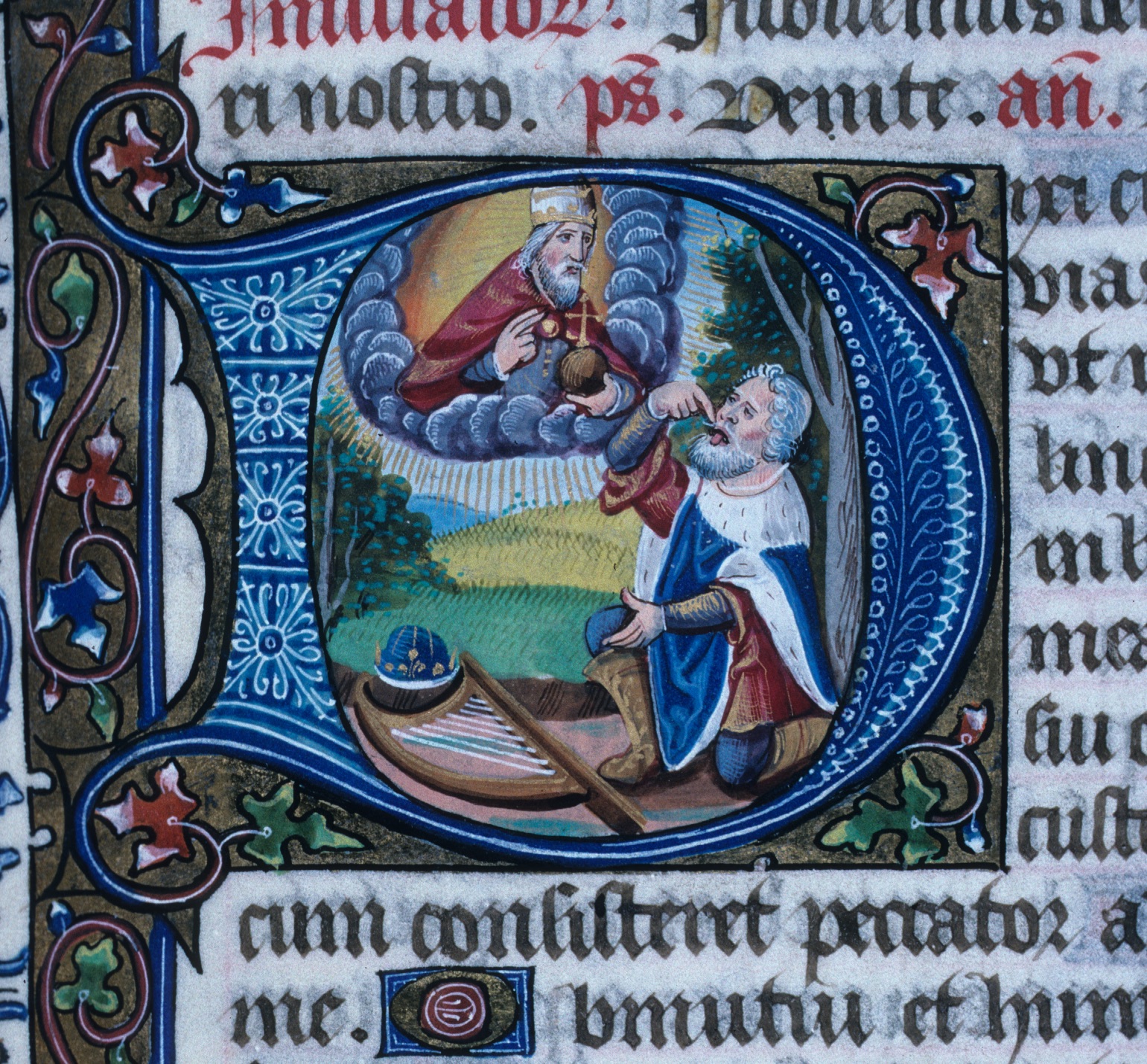
While studying this initial, I decided to use the tools in the updated Index database to explore how David’s pose and the purposeful indication of his tongue were related to the psalm verse. In this Psalter, the initial D for Dixi begins Vulgate Psalm 38, verse 2: Dixi custodiam vias meas; locutus sum in lingua mea posuri ori meo custodiam cum consisteret peccator adversum me… (Douay-Rheims Bible, accessed 22 February 2019, http://drbo.org/). Translated, this reads “I will take heed to my ways, that I sin not with my tongue. I have set guard to my mouth, when the sinner stood against me.” The tongue is mentioned one more time in this psalm at verse 5 with regard to speech, “I spoke with my tongue: O Lord, make me know my end. And what is the number of my days: that I may know what is wanting of me” (drbo.org). The image of David thus prefigures the textual passages of the psalm in that both image and text suggest the speaking and offending capabilities of the tongue. But, how often do we see David depicted with his tongue sticking out? And can we find other contexts for his expressive gesture?
I entered a simple keyword search for “tongue” in the upper right search bar on the Index database homepage and used the Subject Filter to refine my results to David, Communicating with God. Immediately, I located a much earlier scene from a Parisian Bible in the Morgan Library dated to the first quarter of the thirteenth century (Fig. 2). This initial D, also beginning Psalm 38, encloses a beardless, crowned David, looking up toward the face of God and mirroring the action of raised finger to outstretched tongue.
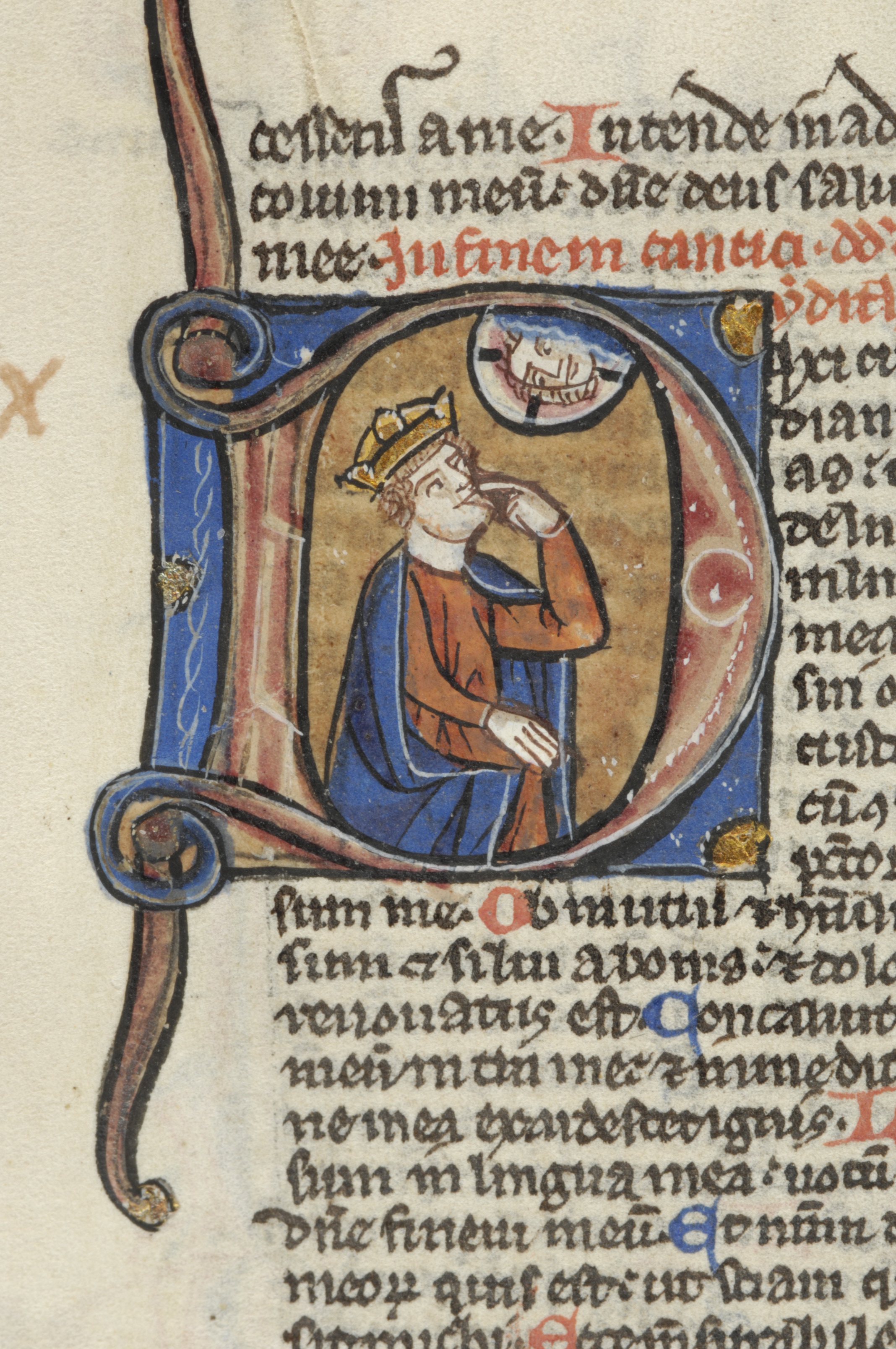
Since both of these images open Psalm 38, the presence of magnified tongues seems intended to show that significant body part that David was obliged to “sin not” with.
This connotation of the image is better understood in the context of the medieval preoccupation with the peccata linguae, or “sins of the tongue,” such as those assigned to fallen characters in the Divine Comedy and the Roman de la Rose. These transgressions of speech include flattery, duplicity, evil counsel, discord, and blasphemy. Medieval moralists also were concerned with sinful tongues: the Franciscan John of Wales (d. 1285), for example, wrote a preaching treatise called De Lingua (“The Tongue”), which outlined the proper duties of a “good” tongue as to share in ethical knowledge and to oppose its own natural “bad” inclinations.
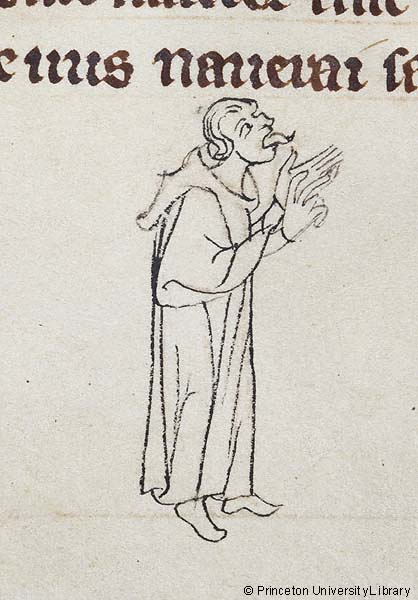
In medieval art, depictions of sinful tongues like David’s can be found in figural representations of Slander, False Seeming, and other personifications of vice. A figure identified as the Unmerciful Judge sticks out his tongue in the lower margin of a 15th century Manuel des Péchés to illustrate the Exemplum, or lesson, for the Sins of Avarice and Covetousness (Fig. 3). His long, curled tongue and raised hands suggest how insistently he imparts this lesson on the vices. However, his prominent tongue is also inherently tied to his cruel speech, offering a visual metaphor of merciless judgment.
Wishing to investigate further the iconography associated with Psalm 38, I used the Index database to browse through the numbered psalms in the Subject Browse List. Clicking the subject heading for Psalm 039 (Vulg., 038) revealed that a majority of the illustrations depict David pointing to his mouth, a common way to represent speech, but without his tongue sticking out. One such initial appears in the Noyon Psalter, attributed to the Master of the Ingeborg Psalter, in the J. Paul Getty Museum (MS. 66, fol. 41v). This suggests that the literal representations of David’s tongue were the more unusual depiction. To take this theory a step further, I repeated the keyword search for “mouth” and refined the subject to David, Communicating with God. This search yielded about 30 examples where David was indicating his closed mouth, a subject that is particularly common in manuscript initials associated with Psalm 38.
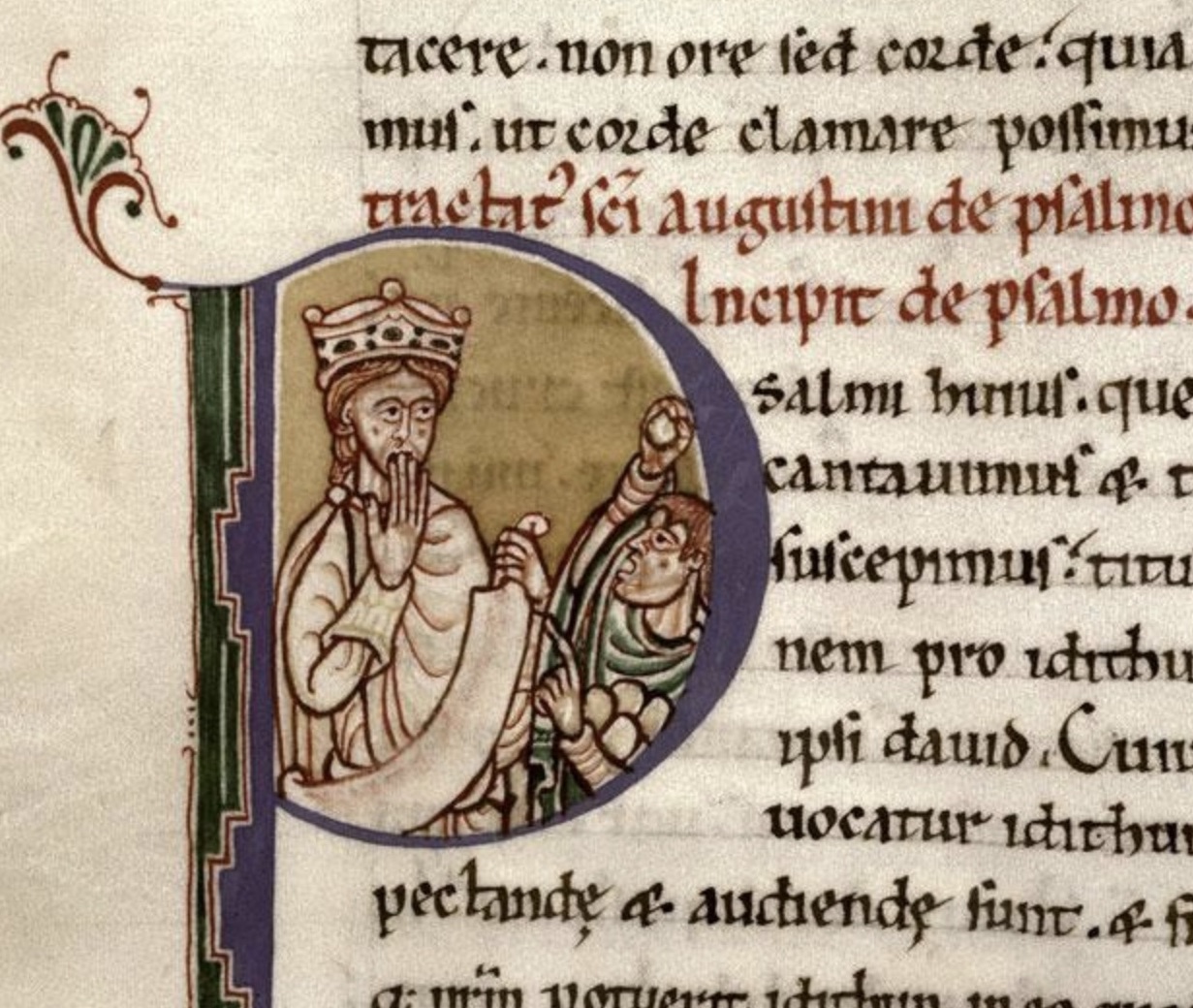
Medieval commentaries on Psalm 38 help to explain the popularity of this iconography. Theodoret’s Commentary on Psalm 38 notes the text’s emphasis on the sinfulness and “lowliness” of human nature and humanity’s need for deliverance, while Augustine wrote of the same psalm that, although the tongue was “prone to slip,” bridling it will help one stand against wicked enemies. Both commentators connected Psalm 38 to an episode in Samuel, where David was viciously pursued by Absalom and abused by Shimei, who threw sticks and stones at him while he fled from Jerusalem. That biblical narrative itself is sometimes found illustrating Psalm 38 (see the related Index subject heading David, Cursed by Shimei). In a manuscript of the Enarrationes in Psalmos, dating to the mid twelfth century, a historiated initial P encloses a crowned David covering his mouth while Shimei hurls stones at him (Fig. 4). Here, David’s cautious gesture and muted tongue show his restraint from sin, shedding light on the meaning of the gesture when it appears in the psalm initials.
Finally, I decided to broaden my search to locate all depictions of this particular body part with David. I repeated the keyword search for “tongue” and set the Subject Filter to David. This led me to a historiated initial in the twelfth century English manuscript of the Saint Albans Psalter and to another layer of iconographic context. Here, the initial E for Erucatavit, beginning Vulgate Psalm 44, encloses a seated and crowned David, who raises a pen in his right hand and with his left index finger points to his extended tongue (Fig. 5). Written in red ink above the incipit is the rubric Lingua me calamus scribae, taken from verse 2 of that Psalm, which can be translated as, “My tongue is the pen of a scrivener”(drbo.org). This verse of Psalm 44 is preceded by the mention of David’s verbum bonum, or the “good word” uttered from his heart to the king (mea regi), suggesting that goodness issues from him and through him, by way of tongue and pen.
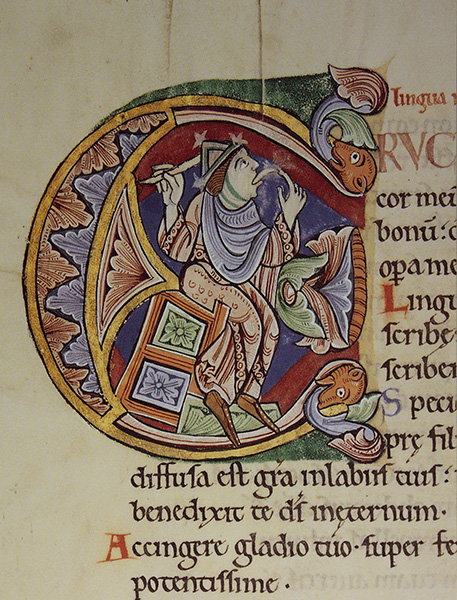
With regard to this Vulgate Psalm 44, Augustine comments,
What likeness, my brethren, what likeness, I ask, has the “tongue” of God with a transcriber’s pen? What resemblance has “the rock” to Christ? (1 Corinthians 10:4) What likeness does the “lamb” bear to our Saviour (John 1:29), or what “the lion” to the strength of the Only-Begotten? (Revelation 5:5)
(Augustine, Expositions, Digital Psalms version, p. 264)
Today, we enjoy ample use of emojis, which add expressive meaning to our messages to one another. In the Middle Ages, manuscript illuminators did not miss the opportunity to illustrate textual passages with similarly expressive visual cues in images, which also linked to the complex layers of meaning readers anticipated finding in the psalms. Although David’s gesture to his closed mouth seems to be a relatively common composition, the emphasis on his stuck-out tongue in certain depictions speaks just as expressively of its sinful capabilities as it does of its usefulness as an obedient tool.
The investigation of David’s “emoji” highlights how researchers can look for specific iconographic motifs in the Index by combining keyword searches in the description field and filtering with controlled headings in Advanced Search options. For advice on your own research topic and forming search strategies using the Index database, send us a Research Inquiry. We’ll be 🙂 to hear from you!
Sources
Baika, Gabriella I. “Lingua Indiciplinata: A Study of Transgressive Speech in the ‘Romance of the Rose’ and the ‘Divine Comedy.’” PhD diss., University of Pittsburgh, 2007.
Craun, Edwin D. Lies, Slander, and Obscenity in Medieval English Literature: Pastoral Rhetoric and the Deviant Speaker. Cambridge: Cambridge University Press, 2005. See especially pp. 33–34.
Douay-Rheims Bible. Accessed 22 February 2019. http://drbo.org/.
Gellrich, Jesse M. “The Art of the Tongue: Illuminating Speech and Writing in Later Medieval Manuscripts.” In Virtue & Vice: The Personifications in the Index of Christian Art, 93–119. Princeton: Princeton University Press, 2000. See especially pp. 108–109.
Hill, Robert C. “Commentary on Psalm 39.” In Commentary on the Psalms, Psalms 1–72, 233–36. Washington, D.C.: Catholic University of America Press, 2000. St. Aurelius Augustine. Expositions on the Psalms, Digital Psalms version 2007, 205–216, 262–277. Accessed 22 February 2019. https://faculty.gordon.edu/hu/bi/ted_hildebrandt/otesources/19-psalms/text/books/augustine-psalms/augustine-psalms.pdf. See especially pp. 205–206, 264–265.
Going to Kalamazoo this year? Ever wanted to learn more about the impact of digital tools and methods on medieval art research? Be sure to circle your programs for two exciting sessions on current topics in iconography, a roundtable and a workshop, co-organized by Maria Alessia Rossi and Jessica Savage of the Index of Medieval Art.
I. Saturday, May 11 at 10:30am [Session 346]
Encountering Medieval Iconography in the Twenty-First Century: Scholarship, Social Media, and Digital Methods (A Roundtable)
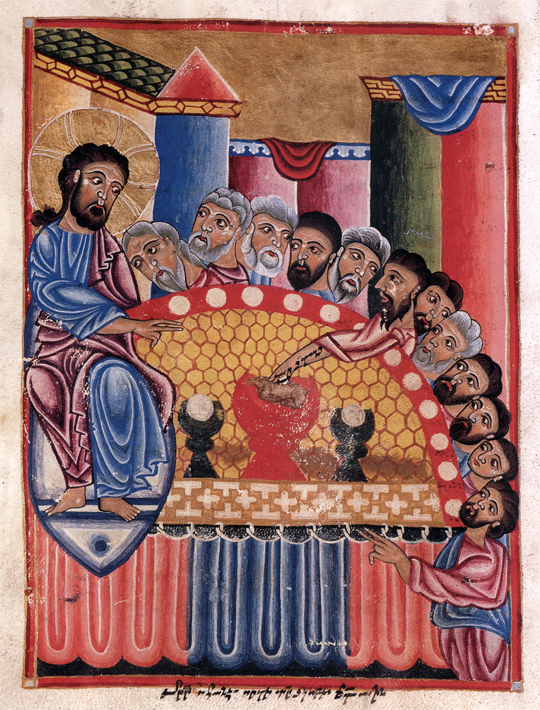
Stemming from the launch of the new database and enhancements of search technology and social media at the Index of Medieval Art, this roundtable addresses the many ways we encounter and access medieval iconography in the 21st century. Our five participants will speak on topics relevant to their area of specialization and participate in a discussion on how they use online resources, such as image databases, to incorporate the study of medieval iconography into their teaching, research, and public outreach.
Digital Information and Interoperability: Facing New Challenges with Mandragore, the Iconographic Database of the BnF
Sabine Maffre, Bibliothèque nationale de France
Ontology and Iconography: Defining a New Thesaurus of the OMCI at the Institut National d’Histoire de l’Art, Paris
Isabelle Marchesin, Institut National d’Histoire de l’Art (INHA)
Iconography at the Missouri Crossroads: Teaching the Art of the Middle Ages in Middle America
Anne Rudloff Stanton, Univ. of Missouri
Medieval Iconography in the Digital Space: Standardization and Delimitation
Konstantina Karterouli, Dumbarton Oaks
Online Resources in the Changing Paradigm of Medieval Studies
Marina Vicelja, Center for Iconographic Studies, Univ. of Rijeka
II. Sunday, May 12 at 8:30am [Session 505]
Lost in Iconography? Exploring the New Database of the Index of Medieval Art (A Workshop)
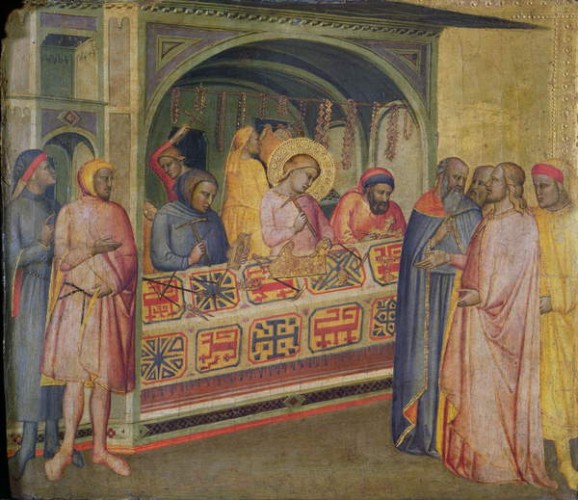
This workshop will demonstrate how to get the most out of the new Index of Medieval Art database by using advanced search options, filters, and browse tools to research iconographic subjects. A short presentation will introduce the new subject taxonomy search tool that will further facilitate exploration of the online collection.
We look forward to an invigorating discussion on current issues in iconographic research and to sharing an update on the new database. You can find out more about the 54th International Congress on Medieval Studies at Kalamazoo, held from 9-12 May 2019, including the full schedule here.
The Index is happy to host the scholarly conference “Abstraction before the Age of Abstract Art,” organized by Profs. Elina Gertsman (Case Western Reserve University) and Vincent Debiais (École des hautes études en sciences sociales) with the generous support of the Samuel H. Kress Foundation, the French-American Cultural Exchange Foundation, Case Western Reserve University, and the École des hautes études en sciences sociales. The conference will be held on May 18, 2019; speakers include Jean-Claude Bonne,
Licia Buttà, Vincent Debiais, Thomas Golsenne, Herbert Kessler,
Robert Mills, and Cécile Voyer.
A full schedule and free registration form will be available after April 7 at https://ima.princeton.edu/conferences.

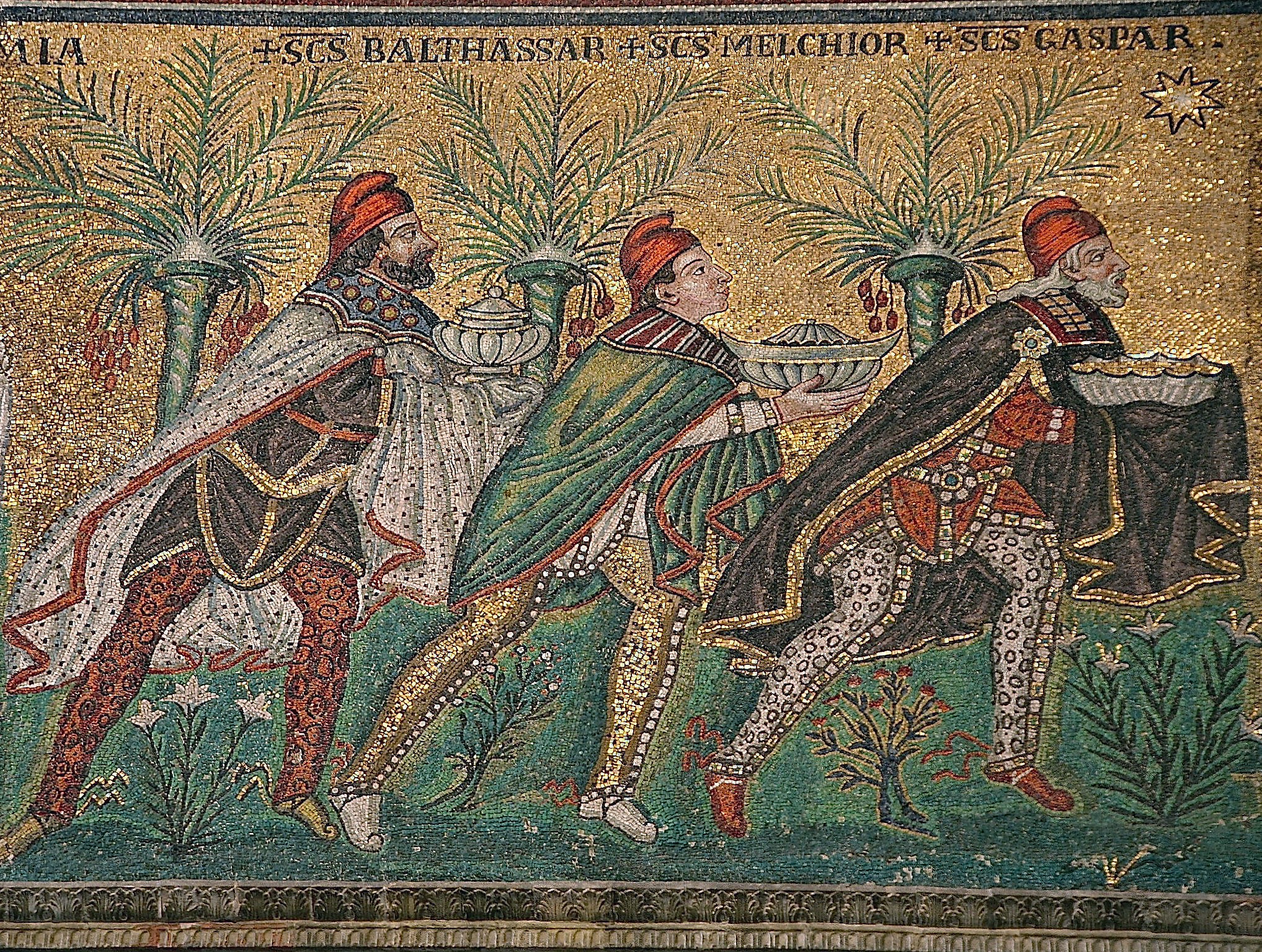
“We three kings of Orient are…” runs the traditional Christmas carol. If you were that kid who wondered “Just who are these guys with their weird-sounding gifts? And where’s ‘Orientare’ anyway?” this blog post is for you.
The story of the Magi originated in the Gospel of Matthew (2:1-12), which tells of “wise men from the east” (magi ab oriente) who traveled to Jerusalem seeking the king of the Jews after seeing a star portending his birth. When they reached Bethlehem, Matthew recounts, they fell and adored him, offering gifts of gold, frankincense, and myrrh. Although this fairly skeletal story offers few details about how the magi looked or from where “in the east” they hailed, that didn’t stop medieval artists from developing their Biblical story into an elaborate visual tradition.
Matthew offers no information about the number of magi who made the trip to Bethlehem. The tradition of depicting them as a trio predominated from the third century onward, perhaps inspired by the three gifts mentioned in the biblical account. Nonetheless, early medieval depictions of the magi in other numbers, such as two, four, or even six, can occasionally be found. Matthew also remains silent about the magi’s names; the ones with which we are familiar today—Melchior, Caspar, and Balthazar—appear much later, in Byzantine texts and images of the sixth century. One of the earliest such instances is the Adoration of the Magi mosaic in Sant’ Apollinare Nuovo in Ravenna, where the elder, foremost magus is labeled Caspar, rather than Melchior, as more often would be the case in later medieval art.
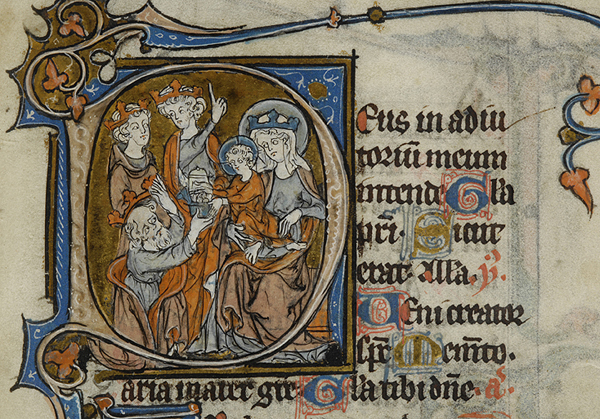
Despite the lack of information about the locations from which the magi came, artists quickly developed ways of visually emphasizing their foreign origins. Early medieval images drew on traditional Roman representations of non-Roman peoples paying homage to the emperor, depicting the magi in appropriately “outlandish” dress such as the short tunics, brightly patterned leggings, and forward-peaked Phrygian caps that appear at Sant’ Apollinare Nuovo. Artistic interest in signaling the magi’s foreign origins corresponded well with Christian exegeses that interpreted the adoration of the magi as symbolic of “heathen” peoples’ recognition of Christ. It was not until the tenth century in western Europe that the magi were reconceived as royal figures, in association with the reference of Isaiah 60:1-4 to the Messiah’s illumination of Gentiles and kings. In many works of art from this point onward, the magi have traded in their traditional caps and trousers for crowns and royal robes, as in the early fourteenth-century Saligny Hours (Morgan Library & Museum, MS. M.60, fol.8r).

From the early Middle Ages onward, the magi were increasingly conceived to be of different ages and geographical origins. In the eighth century, the unknown Irish author nicknamed the “Pseudo-Bede” set down these ideas in writing, describing the magi as of three ages—youth, maturity, and old age—that corresponded to three stages of the life cycle as described by Classical philosophers. Their representation in the ninth-century Stuttgart Psalter (Würtembergische Landesbibliothek, Bibl. Fol. 23, fol. 84r) observes this tradition, depicting them with a white beard, a dark beard, and no beard at all.
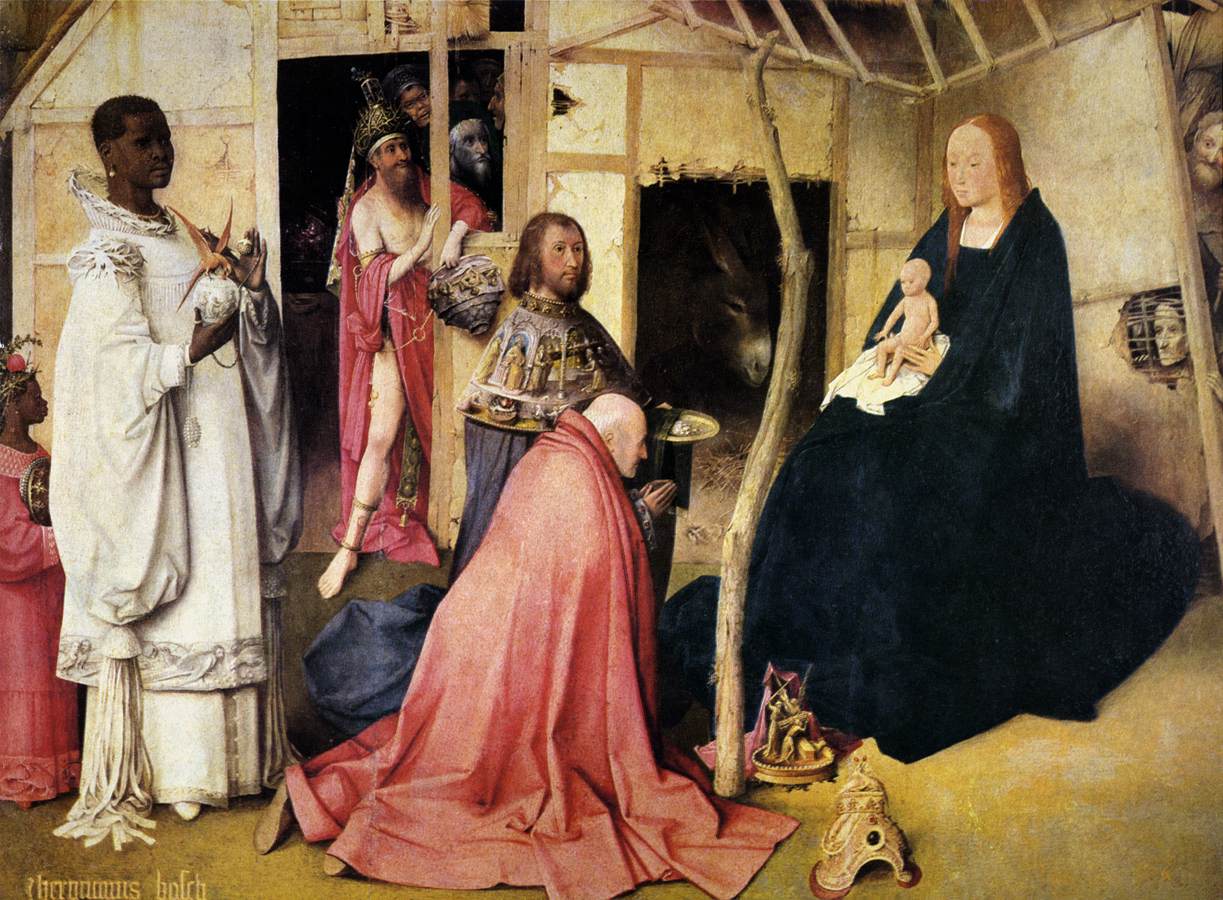
The Pseudo-Bede also described the magi as hailing from the three known parts of the medieval world: Europe, Asia, and Africa. These continents, which formed the basis for the typically tripartite division of medieval T-O maps, were also thought each to have been settled by one of Noah’s three sons, Ham, Shem, and Japeth, with whom medieval thinkers sometimes associated the division of humanity into African, Asian, and European “races.” The late medieval and early modern tradition of representing the magi with ethnic features that European artists tended to associate with each continent—Melchior as a white European, Caspar with Asian features, and Balthazar as a black African—can be traced to this chain of ideas. The opportunity to distinguish the magi as exotic foreigners through their physical appearance as well as through costume and other attributes inspired some of the most elaborate and imaginative portrayals of the later Middle Ages, among them Hieronymous Bosch’s famous 1510 Adoration of the Magi in the Prado Museum. In the Index, many similar images can be found by browsing the subject “Black Magus.”

Extensive image cycles developed around the story of the magi; these illustrate the several stages of their journey, including their questioning of Herod, their sighting of the star, and their arrival in Bethlehem, as well as the dream in which they are warned to avoid Herod and their journey homeward by another route. Over a dozen of these subjects, from “Magi, Adoration” to “Magi, Vision of Christ at Different Ages,” are catalogued in the Index. The most popular subject of all, for medieval and modern viewers alike, is the Adoration of the Magi, depicting the moment when the wise men render homage to the Christ Child in Bethlehem. Portrayals of this event range in both complexity and mood, from the charming, trousered travelers of early Christian tradition to the theatrical processions, replete with angels, gaily costumed servants, and trains of exotic animals (including camels!), of late medieval works like Gentile da Fabriano’s 1423 altarpiece of the Adoration, now in the Uffizi Gallery. Although we still have no idea where these wise guys came from, their presence never fails to bring magic and mystery to the traditional Christmas story.
Someone made each of the works of art described in the Index of Medieval Art, and since the beginning of its online database, The Index has acknowledged the individuals and workshops responsible for generating illuminated manuscripts, sculptures, mosaics, et al. when their identities are known. In the original Index system, artists and scribes each occupied a separate field, however, in the updated Index a new field has been established to incorporate both roles under the title of Creator. This reflects the fact that in some media, such as manuscript illumination, the roles of scribe and artist were not always separate: at times one individual undertook both kinds of work, while in other cases the jobs were more specialized.
The Index here expresses a caveat: Creator will not appear on every record. Medieval artists and scribes were/are largely anonymous, creating unsigned works of art for patrons who were also frequently unknown. However, some of the approximately 1400 creators who are named in the Index are known because they signed their works. Others were acknowledged by patrons who named artisans in their inventories, and still others have been identified by modern art historians who have spotted enough similarities among groups of works to assign a nickname for their otherwise anonymous master.
You can learn more about the artist associated with a particular work of art by looking at the work of art record, where the Creator field is located just toward the bottom. In the example below, a screen shot of a manuscript main record shows the name of Simon Bening as creator.
Click on the name, and another window will open providing information about the creator, including such information as general notes, alternate names, bibliographical citations, profession/s and work of art references. This last bit of information presents a list of all works of art associated by the Index with the artist. In the case of our example Simon Bening, this includes some 250 manuscript folios attributed to the artist and included in our database. The researcher can then click through the records to view these works.

You can also browse by Creator name to see the information and records that the Index includes for a particular Creator. Choose the Browse option on the home page, and from the Browse Indices, click on Creator to open an alphabetical list of names. To find the artist or scribe of interest, either scroll through the list or type the desired name on the line below “Creator” at the top of the list. Click on the correct name, and a window will open as above.

The information about artists and scribes is intended to provide a springboard for further research. Citations frequently include an article in Oxford Art Online, many of which are followed in turn by relevant bibliography.
Although as noted, most medieval artists and scribes are unknown, The Index does include nearly 1400 “named” creators. A significant portion remain personally anonymous, but have been given monikers based on the attribution of works of very similar style or other details, such as the Gold Scrolls Group, named for a distinctive style of ornament, or the Master of Catherine of Cleves, a name based on work created for a specific patron. Searching Grove Art Online for “Anonymous Masters” will yield page after page of unknown creators whose works have been linked in this way to create a body of work by one artist, scribe or workshop. Because many of these names are still in use in art historical scholarship, the Index includes them in the Creator list, sometimes designating them as “see from” terms when consensus about authorship is not clear. We love to keep our records updated, so if you know of new research about the attribution of a work of art, please bring it to our attention at theindex@princeton.edu.
Judith K. Golden
Registration for the Symposium “Eclecticism at the Edges: Medieval Art and Architecture at the Crossroads of the Latin, Greek, and Slavic Cultural Spheres” is now open. The Symposium will be held on April 5-6, 2019 in 106 McCormick Hall on the Princeton University campus. This event is free, but registration is required to guarantee seating.
For details about the Symposium, please check the event web page at https://ima.princeton.edu/conferences/
We look forward to seeing you!
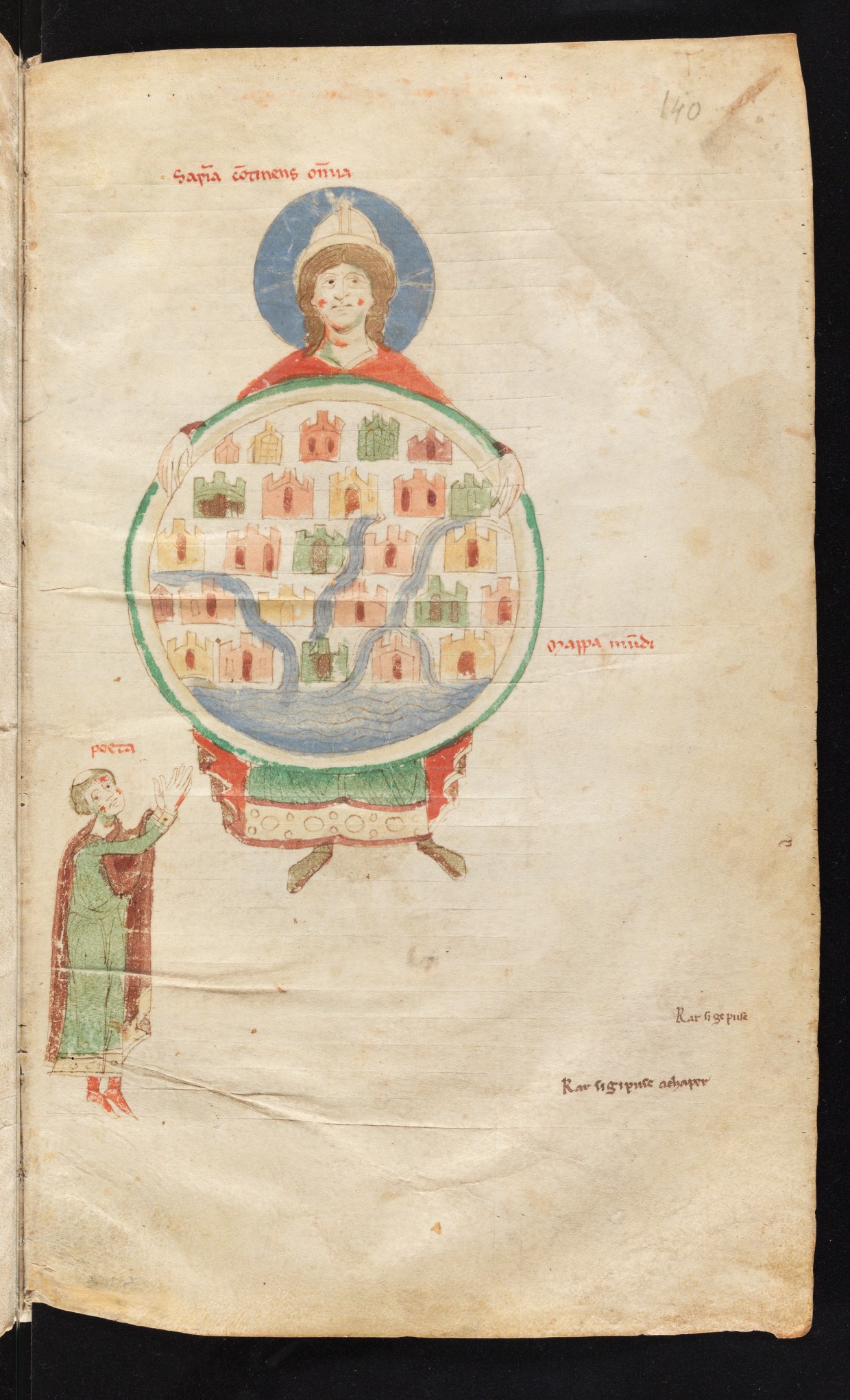
Wisdom holding a Map of the World, from Petrus de Ebulo: Liber ad honorem Augusti (Bern, Burgerbibliothek, Cod. 120.II, fol. 140r)
Registration for the Nov. 17 Index conference “Out of Bounds: Exploring the Limits of Medieval Art” is now open. Lectures will take place in 101 McCormick Hall on the Princeton University campus between 9-5, with a reception to follow in the Palmer House. Registration is free but required to guarantee a seat. For details about the conference, please check the event web page at https://ima.princeton.edu/conferences/. We look forward to seeing you!
cordially invites you to join us for our
Thursday, September 20, 2018
4:00-6:00 pm
McCormick Hall, A Level
Join us for refreshments, meet the Index staff, and catch up with the medievalist community.
Enter a raffle to win books on medieval art.
Learn how the Index can support your research!
54th International Congress on Medieval Studies, Kalamazoo, MI, May 9 to 12, 2019
Sponsored by the Index of Medieval Art, Princeton University

Organizers: M. Alessia Rossi and Jessica Savage (Index of Medieval Art, Princeton University)
Stemming from the launch of the new database and enhancements of search technology and social media at the Index of Medieval Art, this roundtable addresses the many ways we encounter medieval iconography in the twenty-first century. We invite proposals from emerging scholars and a variety of professionals who are teaching with, blogging about, and cataloguing medieval iconography. This discussion will touch on the different ways we consume and create information with our research, shed light on original approaches, and discover common goals.
Participants in this roundtable will give short introductions (5-7 minutes) on issues relevant to their area of specialization and participate in a discussion on how they use online resources, such as image databases, to incorporate the study of medieval iconography into their teaching, research, and public outreach. Possible questions include: What makes an online collection “teaching-friendly” and accessible for student discovery? How does social media, including Twitter, Facebook, and blogging, make medieval image collections more visible? How do these platforms broaden interest in iconography and connect users to works of art? What are the aims and impact of organizations such as, the Index, the Getty, the INHA, the Warburg, and ICONCLASS, who are working with large stores of medieval art and architecture information? How can we envisage a wider network and discussion of professional practice within this specialized area?
Please send a 250-word abstract outlining your contribution to this roundtable and a completed Participant Information Form (available via the Congress Submissions website: https://wmich.edu/medievalcongress/submissions) by September 15 to M. Alessia Rossi (marossi@princeton.edu) and Jessica Savage (jlsavage@princeton.edu). More information about the Congress can be found here: https://wmich.edu/medievalcongress.
Fourth in a series of short blog posts introducing new features of our online database
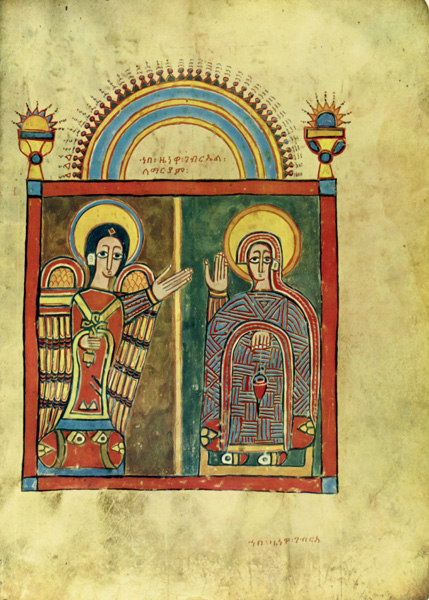
Did you know that you can filter Index search results by style and/or culture of origin? The “Style/Culture” field on the search filters page groups results according to widely used stylistic or cultural categories, such as “Gothic,” “Ethiopian,” or “Jewish.”
As any student of art history knows, stylistic and cultural labels can be difficult to define. Stylistically speaking, what’s “Gothic” in France in 1150 may be considered “Romanesque” at the same date in Italy, while the parameters for ethnic, religious, or other cultural communities can vary even more dramatically. Still, because we’ve observed that students and other new users of the Index may find such labels helpful in narrowing and exploring search results, we’ve elected to keep them in our new database, consulting authorities such as the Getty Art and Architecture Thesaurus and even current medieval art textbooks to refine how we apply them. If you’d like to learn more about why we applied a particular “Style/Culture” label to a work of art, you can look at the authority record for that label.
Because style and culture terms remain subjective even in the best of circumstances, they may not yield precise results and are most usefully applied when you are searching broadly to learn how a subject was represented in a particular period or cultural sphere, rather than to search for a particular example. You might find, for example, that searching for a frequently represented subject such as “Virgin Mary: Annunciation” delivers an intimidating 2500+ results. However, if what you really wanted was to see examples of how the Annunciation was depicted in Byzantine art, narrowing the results by using the “Style/Culture” delimiter “Byzantine” reduces this to a much more manageable—and more relevant—list of 276 records.
Some delimiters will still deliver a high number of results (try using “Gothic” instead of “Byzantine” to see what we mean), but you can refine these further by using additional filters—such as Date, Location, or Medium—when you’re ready for more specificity. To apply the Style/Culture filter, type a search term into the free text field at the upper right of the search window. On the results page, choose the “Filters” option, then in the “Style/Culture filter, begin typing the term you’re looking for—the system will auto-complete the term, if it exists—and then, once you’ve selected the term you want, simply click “Search.” The filtered results will appear below.
If you’d like to view a complete list of Style/Culture terms currently used by the Index, click on “Browse” at the top of the window and then choose Style/Culture. To expedite your search for a particular term, type it into the search line at the top of the list.
As always, if you have questions or comments about the Index of Medieval Art database, please contact theindex@princeton.edu. We’re here to help, and we want to know what you think.